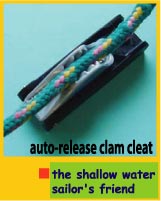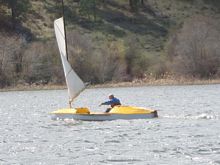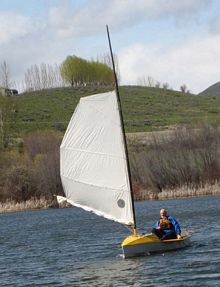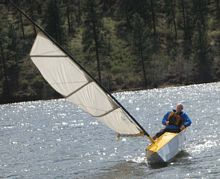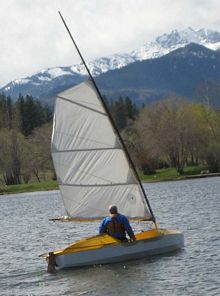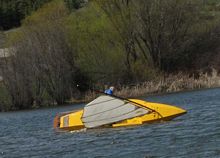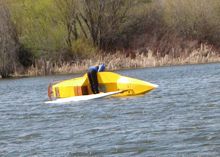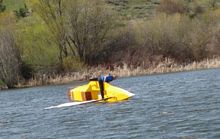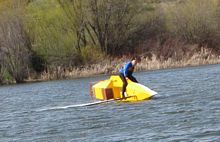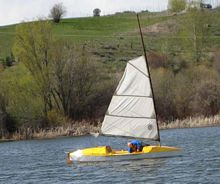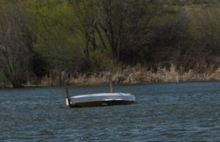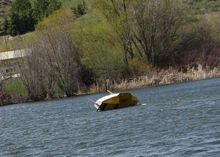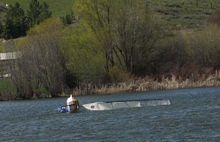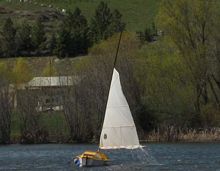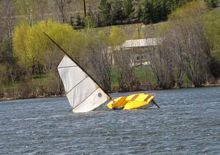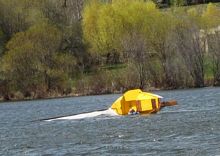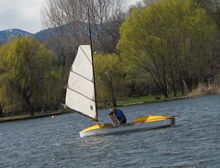
 Custom Search
|
| sails |
| plans |
| epoxy |
| rope/line |
| hardware |
| canoe/kayak |
| sailmaking |
| materials |
| models |
| media |
| tools |
| gear |
| join |
| home |
| indexes |
| classifieds |
| calendar |
| archives |
| about |
| links |
| Join Duckworks Get free newsletter CLICK HERE |
|
|
| Marsh Duck |
by Scot Domergue - Seattle, Washington - USA |
Testing - New Sail and Rigging, CapsizePearrygin Lake, April 20, 2013I hauled the Marsh Duck from Twisp to Pearrygin Lake behind my bicycle - 13 miles with headwinds and a few hundred feet of climb. I was quite tired by the time we got there. My friend Leona and I relaxed on the grass and had lunch. Then I put the Duck in the water and tried turning her over, empty and without rigging, just to get an idea of what would happen. When she was completely upside down, some water came in through the hatches - which was no surprise as they're not water tight. The wind was quite strong and very gusty. I rigged her with her new, larger sail and longer spars, but with one reef in. When I got out on the water it was very clear that trying it without a reef would NOT have been a good idea!
I was sorting out new rigging and it was challenging sailing, AND FUN!
And then it was time to see how she’d do with a capsize. I had eight gallons of water in jugs in the storage spaces under the cockpit floor to give her about the weight I normally have when cruising.
It was easy enough to get her over, and with the sail on the water, I was able to climb over the high side, put a foot and some weight on the dagger-board, and dive back into the cockpit as she came upright. I was never in the water, and the cockpit didn’t take on any water. Very nice.
I immediately started sailing again, and within a few minutes, was hit by an unexpected gust and didn't make the right moves. Over we went again. This time, when I tried to climb over the high side, due to some combination of timing and wind, my weight was too far toward the sail, and forced her on over. In spite of foam in the mast she went completely upside down!
I pushed down on the wing, reached up for the dagger-board and pulled, and the mast was horizontal again.
The dagger-board slipped on through its trunk into my hand. But I was able grab the edge of the side deck and keep her coming up. I tossed the dagger-board into the cockpit and the wind kept her coming.
Back over with the sail in the water on the other side. So I worked my way around the stern, reached up, and grabbed the edge of the side deck. She came right up and I floundered over the side deck and into the cockpit.
I had to put the dagger-board back in before I could sail again.
It all went quite well, and I learned some things. Unless I'm really on my game and sure I can make it in time, I won't try to go over the high side, but rather will drop into the water and work my way around the stern to the dagger-board (or maybe dive under the boat if the water is warm). That way I think I'll be able to keep her from turning turtle in all but the most horrendous conditions. You can see from the pictures that she rides pretty high in the water when on her side. I think that the hatches stayed out of the water until she turned turtle. Since my hatches are not water tight, she did take on water when completely upside down, but only a few gallons. The cockpit seemed to always stay out of the water. Even after turning turtle and taking on water in the cabin and storage spaces, the Marsh Duck was ready to sail as soon as she was upright and I was back in the cockpit. There was no bailing needed - though if she were somehow totally swamped with cabin and storage compartments full of water, that would be a very different situation! Ultimately I'd like to make all the hatches truly watertight. It's also possible to install small interior hatches to make 5 to 7 separate watertight compartments. I've also thought about using inflatable whitewater canoe floatation bags - in addition to the rigid foam floatation that's under the side decks and more that I'll probably add in the bow. I have a metal "stop" that keeps the dagger-board down (so it won't float up in the trunk). Perhaps I also need something to keep it from sliding on out through the bottom? Since the board floats it won't go through when it's down in the water, but sticking out horizontal, ABOVE the water it slid out pretty easily. I was pleased with my new, larger sail and with the rigging, though I'm sure I'll be tinkering with it for a while. I've ordered hardware to make reefing much easier. I think it will take some experimentation and practice to be able to gracefully and quickly reef out on the water in strong winds in a sailing canoe! I bought NRS Endurance Paddle Pants and Jacket a couple of weeks ago. I'm very pleased with how they perform. This is NOT a dry suit, but I spent some time in the water, all but fully immersed, and the synthetic clothing I wore became only slightly damp. The water was VERY cold (Pearrygin Lake was frozen over not so long ago), and I was quite comfortable. The Marsh Duck is easy to bring back upright, but she showed no sign of self-righting. Still, I wouldn't count on her staying down and not blowing away if I end up in the water. It's important to be tethered and to keep hold. Plans for Marsh Duck are available at Duckworks See scotdomergueblog.wordpress.com for continuing adventures with the Marsh Duck. |
|
